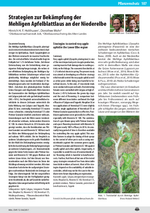Strategies to control rosy apple aphid in the Lower Elbe region
Rosy apple aphid (Dysaphis plantaginea) is oneof the most important pests in apple production,
causing massive fruit damage due to sucking activity
on the foliage. The economic threshold is at
1-2% infected shoots in spring. The present study
was aimed at developing an e2 ective strategy
which would control the rosy apple aphid as well
as other pests while being non-harmful to bene
D cial insects. To this end, 27 insecticide trials
were conducted in open orchards. Overwintering
females were controlled with Calypso at high ef-
D cacies (>95%) between the green-tip stage
and the end of H owering. A comparison between
di2 erent insecticides conD rmed the high
eJ cacies of Calypso and Teppeki. Mospilan SG or
two applications of NeemAzal-T/S were slightly
weaker, single applications of NeemAzal-T/S or
Pirimor Granulat appreciably less e2 ective. Postbloom
applications were generally less e2 ective,
especially with Movento SC 100. The combination
of a pre-bloom spray with Pirimor Granulat
and a post-H owering treatment with Movento SC
100 gave nearly 100% eJ cacy in 2016. An unusually
long period of time is therefore available
for controlling the rosy apple aphid. This enables
farmers to adapt the timing of their sprays
to the control of other pests such as using neonicotinoids
against the common green capsid,
or Pirimor Granulat and Movento SC 100 against
woolly aphid and other aphids. Importantly, it
is possible to avoid the use of neonicotinoids after
H owering which is harmful to beneD cial insects.
Further, fruit from all but one of the tested
spray strategies remained free from detectable
insecticide residues at harvest. Most of the strategies
depend on the availability of suitable insecticides,
which may not be the case in the medium-
term future depending on registration.
Documents

|
Strategies to control rosy apple aphid in the Lower Elbe region () Rosy apple aphid (Dysaphis plantaginea) is one of the most important pests in apple production, causing massive fruit damage due to sucking activity on the foliage. The economic threshold is at 1-2% infected shoots in spring. The present study was aimed at developing an e2 ective strategy which would control the rosy apple aphid as well as other pests while being non-harmful to bene D cial insects. To this end, 27 insecticide trials were conducted in open orchards. Overwintering females were controlled with Calypso at high ef- D cacies (>95%) between the green-tip stage and the end of H owering. A comparison between di2 erent insecticides conD rmed the high eJ cacies of Calypso and Teppeki. Mospilan SG or two applications of NeemAzal-T/S were slightly weaker, single applications of NeemAzal-T/S or Pirimor Granulat appreciably less e2 ective. Postbloom applications were generally less e2 ective, especially with Movento SC 100. The combination of a pre-bloom spray with Pirimor Granulat and a post-H owering treatment with Movento SC 100 gave nearly 100% eJ cacy in 2016. An unusually long period of time is therefore available for controlling the rosy apple aphid. This enables farmers to adapt the timing of their sprays to the control of other pests such as using neonicotinoids against the common green capsid, or Pirimor Granulat and Movento SC 100 against woolly aphid and other aphids. Importantly, it is possible to avoid the use of neonicotinoids after H owering which is harmful to beneD cial insects. Further, fruit from all but one of the tested spray strategies remained free from detectable insecticide residues at harvest. Most of the strategies depend on the availability of suitable insecticides, which may not be the case in the medium- term future depending on registration. |
Details
- Activity type
- Publication in technical journal
- Activity work package
- Reduction in pesticide residues
- Activity number
- OVA-WP3-A15
- Activity contact
- Hinrich Holthusen, Dorothee Mohr
ESTEBURG-Obstbauzentrum Jork
Obstbauversuchsring des Alten Landes e.V.
Moorende 53
21635 Jork
Telefon: 0 41 62 / 60 16 - 0
Fax: 0 41 62 / 60 16 - 600
E-Mail: [email protected]
- Activity partner
- OVA
- Activity country
- Germany
- Last edit
- 25-08-2017

The EUFRUIT thematic network has received funding from the
European Union's Horizon 2020 research and innovation programme
under grant agreement No 696337.
European Union's Horizon 2020 research and innovation programme
under grant agreement No 696337.